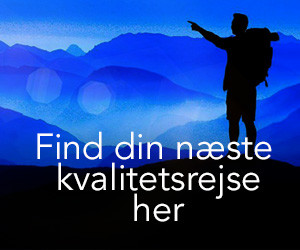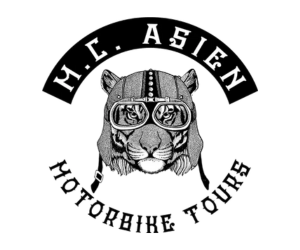Omo Valley in Ethiopia: Manhood test, bare ass and AK47 is written by Soren Bonde.

The trip goes to the Omo Valley, Ethiopia
I'm jumping on the plane in Ethiopians capital, Addis Ababa and flies to Arba Minch in the south of the country. Here I am met by a wide smile on a friendly brown face: "Welcome, my friend - good to see you again!" I first met Andualem in 2011, where I, as a prelude to visiting “the world’s warmest place” in the north Ethiopia, spent eight days south in the Omo Valley.
I wanted to find out if there was enough material for a later project on tribal people. It was there to that extent. The valley's 16 different ethnic groups are quite different, and many live very primitively and remotely. Now I'm back small two years later and it feels just right. Andualem pulls me over to the four-wheel drive and introduces me to our driver Asrat. "I put the Toyota in order for you to come," says Andualem.
He is a fresh guy in his mid-thirties and undoubtedly one of those who knows the Omo Valley and its people best. He speaks fluent English and seven different tribal languages, and he has traveled across the valley since he was a child. While Asrat fills the tank, as well as the many cans on the roof, I review the expedition along with Andualem.
We have a loose plan to visit two or three tribal people and stay with them for a week. I want to go out to some of the most remote villages that are as little affected by civilization as possible. And I will try to document some of their very special rituals on film and pictures.
An hour after we leave civilization, darkness begins to fall. The car's headlights catch men and boys on their way home with the cattle. The roar of the animals mixes with the car radio and the monotonous engine noise, and I enjoy the sunset through the side window.

Flood on the trip to the Omo Valley
We follow the plan and drive towards the southern part of the Omo valley to the same hamer village that I visited two years ago. We have been informed that the village is preparing a manhood test. It is a very special ritual that I did not manage to experience last time and this time I will not want to miss it. But the heavy clouds on the horizon are not such to discuss with, and we are delayed by several rain showers.
After 10 hours of driving, the car suddenly stops and the monotonous jump disappears. The driver frustratedly hammers a fist into the steering wheel. The potholed dirt road has turned into a foaming mud hole, which even our four-wheel drive driver must see himself defeated by. Andualem steps out with a flashlight in one hand and a shovel in the other. The front of the car has sunk well into the mess.
The tires find nothing to grab. The rain is pouring down, and 10 meters further ahead a small river runs across the road. "We will stay here until tomorrow morning," Andualem states calmly. "We have to wait until the rain in the mountains stops." I find another shovel, and together we dig the wheels free.

Idle and plate men
The row break I try to find a comfortable position, but it is impossible to sleep. We are less than two hours drive from the village, where the festivities have probably already begun. Frustrating. It was planned that we would sleep there tonight, but in the Omo Valley it rarely goes as planned. I knew that in advance.
Still, I chose one of the most remote villages in the Omo Valley, which is very rarely visited. If you want to make it less difficult for yourself, you can visit the villages that are close to the road. On the other hand, they are used to tourists - the kind that stay for half an hour and pay to take some quick pictures with the natives. It destroys the villages and their impression of the outside world, and I will not contribute to that.
Earlier in the day, we passed a group of mursies who jumped out on the road in amazing costumes and started dancing in hopes of earning a dime. They are very distinctive and photogenic. The women of the Mursies have large holes in their ears and lips, which are filled with wooden or clay discs. Some are up to 15 cm in diameter, and from there comes the term 'plate connoisseurs'.
That was when one was not so politically correct. To us it looks insane, but with the mortars it is a sign of beauty. Such a performance is enough to satisfy most tourists. But I want the real thing, and that's why I'm stuck in a mud hole.
I curse my stubbornness, but then come to mind that precisely this driving force has given me the most amazing experiences worldwide. My adventure usually begins where the road ends.

A warm welcome to the Hammer people
Eventually I fall asleep in the back seat. When I wake up again, it's still dark, but the rain has stopped. The water level in the 'river' has dropped, and an hour later we are forcing the water masses. It is three o'clock at night when we arrive at the village.
The Hamer people live very primitively. The jeep's headlights reveal a group of thatched cabins around an open space. The faint glow of a fireplace disappears behind a bunch of slender silhouettes; three men have come out to receive us.
I immediately catch sight of Nielaman, who I lived with in 2011. He also recognizes me and welcomes me with a wide smile and a solid handshake. I am politely referred to a small cabin. It is sparsely furnished with two primitive 'wooden beds' and a piece of furniture resembling a table.
On one bed lies a man sleeping. There do not appear to be mosquitoes here and it should not be high season for malaria. I drop the mosquito net and fall exhausted on the other bed.
Did you know: Here are 7 of the best local food markets in Denmark!
7: Green Market in Copenhagen
6: Eco market in Randers
Get numbers 1-5 immediately by signing up for the newsletter, and look in the welcome email:

Thin coffee and bones
Already at half past five I wake up after a restless night's sleep. It itches all over my body and I count 18 mosquito bites. Andualem sticks his head in the door and explains that my sidekick on the bed has malaria. Magnificent. Could he not have said that last night?
However, the curiosity about what the day will bring quickly overcomes the concern over whether one of the 18 mosquitoes were carriers of the parasite. The day begins like any other day in a Hamer village in Ethiopia.
We gather in Nielaman's cabin, which consists of one large room, which is very dark and smoky. The only light source is the embers from the open fireplace. It takes a few minutes to get used to the darkness. The village is rarely visited, so the joy and curiosity is great. Ten pairs of big eyes stare at me and I stare back. It's like stepping back to the Stone Age.
Men, women and children sit along the walls. They carry sparse strands of animal skin on their bodies. The women's decoration consists of bracelets made of metal or wickerwork. It immediately strikes me how properly the cottage is decorated. Everything has its place and nothing lies and flows. The floor is of earth, but freshly swept and fine. On the fireplace stands a large metal kettle and boiler.
They have obviously traded for it from outside the Omo valley, or Andualem has had it with them. This time we had 50 kilos of rice and 20 kilos of coffee shells as a gift. The rice is an important supplement to their diet and the coffee shells are being served. They are boiled with water to a light brown liquid, which is poured into a split pumpkin peel the size of half a football.
The skull goes around and we drink in turn. It tastes of grain and only a hint of coffee. Some peeled animal bones on a wooden platter are offered around. Nielaman's family talks quietly to each other and looks at me. A couple of men are lying and resting. A woman grinds corn kernels into flour between two stones while her bare breasts dangle back and forth.
Go Trekking in Ethiopia - see travel offers here
Lots of Masas
I're leaving the cabin. Outside, two small dirty children are playing on the ground while the sun is setting. Their mothers arrange each other's hair. A reddish clay mass is gently smeared into the hair so that it clumps together like rasta braids. This hairstyle is time consuming and a sign of beauty in the Omo Valley. The silence is gradually broken by song and truthorn - the party is about to begin and people arrive in large numbers from the neighboring villages.
Everyone is long overdue to prepare for the bullfight, bull jumping, which must take place before sunset. Tirespring is a manhood test among the hammer people, which all teenage boys must complete as part of their development. They gain respect and are accepted into the ranks of men. Under a half-roof of palm leaves sits a large group of young men.
They are 'masas' - ie. bachelors who have themselves undergone the ritual. Now they travel from village to village around the Omo Valley until they get married, to help other boys through the ritual. I put one camera away from me and film them with the other. They quickly understand the magic of the camera and soon take photos to the right and left. A group of half-naked girls dance defiantly into the crowd as they sing and trot monotonously into their horns.
They squeal as they are photographed by their peers and see themselves on display for great amusement for the boys. With difficulty I get the camera back, and the Masas immediately pose for group photos with silly grimaces. It's fun and time flies. We communicate without speaking the same language. A third group of older men look at us from a distance.
They are small but too old to fool around. Instead, they look deep into the clay jugs, which this morning were filled with a fermented beverage. The men's traditional costume is complemented by an AK47. Unfortunately, it has gained ground among many tribesmen due to the conflict in neighboring Somalia, which destabilizes the entire Horn of Africa.
Take a cultural trip in the Omo Valley, see travel offers here

Bullfighting in the Omo Valley
In the middle of the afternoon we all gather in the large square around a portal of branches. A bull is symbolically pulled through, and this is how the hammer people show their respect for the animal on which they are completely dependent in order to survive. Some young women hand over thin branches to selected masas so that they can be whipped. Reluctantly, the men let the branches flick over the women's bare backs, but the women do not prefer a mine.
This little ritual is a foretaste of what awaits them on the day they are to be married. The backs of married women are filled with long scars after whipping. When a woman is getting married, she lets herself be whipped for as long as she wants. It is a sign of sacrifice and devotion to her husband and her tribe. The more pain she endures, the stronger bond she forges. It is expected, in turn, that the man will protect her with his life should the need arise. Love really hurts.
The other Masas are busy capturing 16 bulls roaming free in the area. It takes its time. They are skilled cowboys who take the bulls by the horns and capture them for the ritual. Then the bulls are lined up, while other men make sure they do not run away. A group of women dance happily around the square. The rest of the village and all the guests form a circle around the square, dance and at the same time make sure that the bulls cannot run away.
When all the bulls are finally gathered, the center of the ritual arrives. A boy, who is probably about 15 years old, is ready. He's completely naked, but that does not seem to bother him in the slightest. The Masas make sure that the bulls stand completely close and fairly still. Then the boy puts in focused running while we all howl in excitement.
Meet the tribes of Ethiopia in the Omo Valley book your trip here


To shame or a real man
Effortlessly he jumps up on the back of the first bull and continues in elegant running over the backs of the other 15 before jumping down on the other side. If the boy falls or fails with his runs, he is to the great shame of the village and his family - and himself. Something fascinating I experienced was considering how everyone is focused on the ritual. There is no doubt that it strengthens the unity of the village.
The boy turns around and repeats the bull leap now in reverse order. A bull moves, the boy briefly loses his footing and is about to fall down between the large animals. At the last minute, he regains his balance and manages the cuts. The stubborn bull gets a slap from a masa and straightens. Only after seven races does the boy stop and the bulls are released. He has performed the ritual with bravura and now he is considered a man. Only four races are required so his family can be proud.
The ritual is well over, and the old people go home. But the young people party until late in the evening, because now they have a rare opportunity to make new acquaintances with other villages from the Omo Valley. A little in doubt if I'm too old, I hang out for a few hours with the youngsters before finally going back to my cabin.
For the next few days, I absorb impressions and experience the course of life in a hammer village. Nielaman has offered to show me around. Maybe we'm going hunting. Maybe we're stealing honey from the bees in the acacia trees. Or we go for a walk with the cattle. It does not matter. The sense of time disappears just as quietly here. Spontaneity reigns, and planning is an unknown phenomenon.
The trip to the Omo Valley in Ethiopia was an experience I will soon forget.
Read about other exciting countries in Africa here














































Add comment